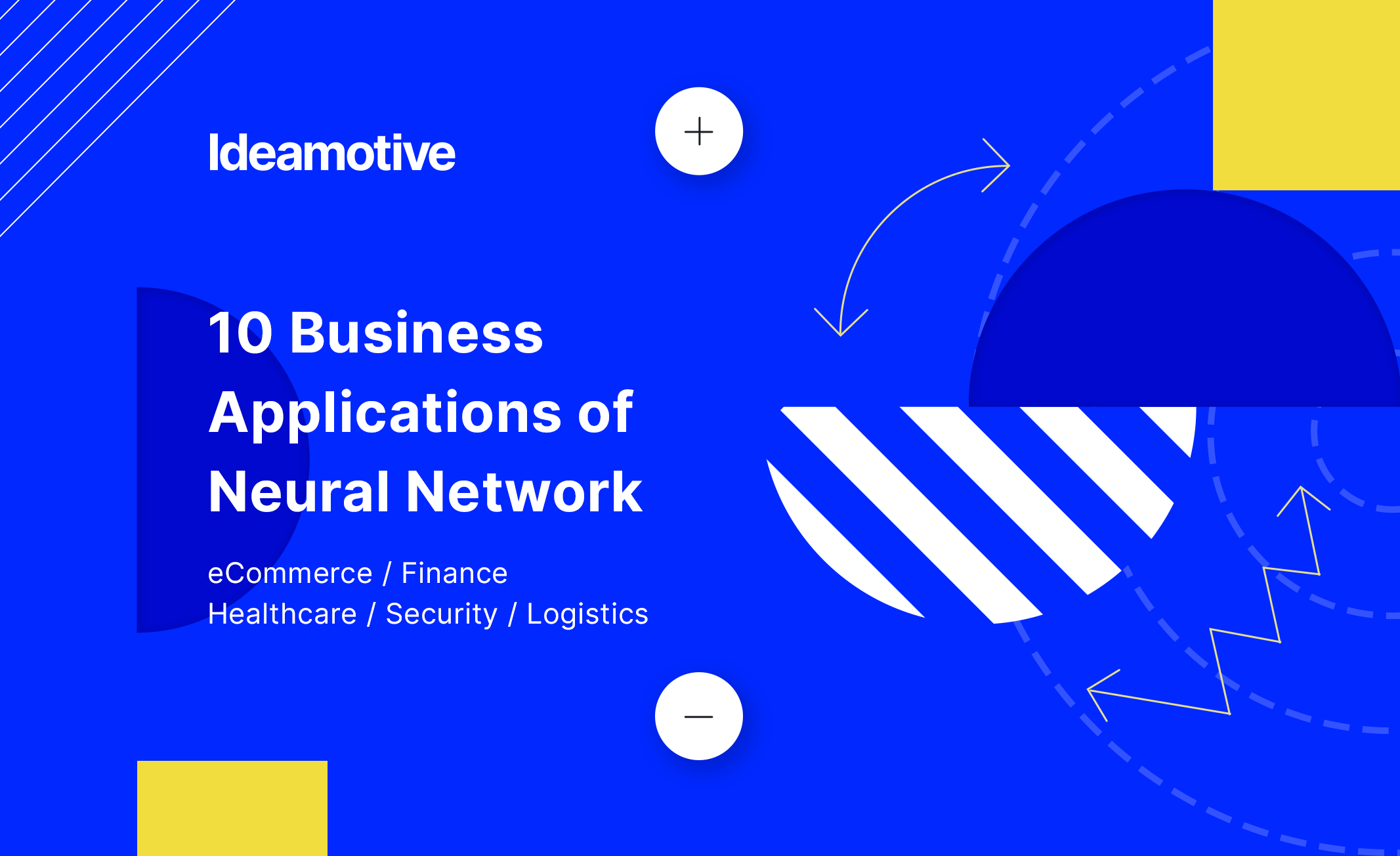100 Artificial Intelligence Statistics For 2022: The Ultimate List
Jan 21, 202214 min read

Miłosz Kaczorowski
Co-founder at Ideamotive. Technological advisor and software consultant.

Artificial intelligence is an integral part of a growing number of industries and a key tool for transforming and strengthening them.
Large global companies still make mistakes in the chosen approaches and systems launched and fear the unnecessary investment of time and money required for this.
However, technical progress cannot be shunned forever by relying only on fear of risk, and if not confronted with it now, it could be even more expensive in the long run.
In this regard, many smaller-scale enterprises still prefer to take risks rather than lose a competitive advantage in the market, and therefore not only actively invest in innovation but also explore new opportunities for using AI in various business processes. And the growth of AI across all industries today shows how quickly it is gaining traction even in traditionally conservative areas and how quickly it is changing the existing business landscape.
Here’s a look at the current state of artificial intelligence statistics and what lies ahead.
Up-To-Date Artificial Intelligence Statistics
AI and Covid-19
1. According to IDC analysts, the spread of the coronavirus COVID-19 will lead to explosive growth in spending on artificial intelligence in the world, who announced their forecast on April 9, 2020. In the wake of the COVID-19 outbreak, AI experts said that many industries, such as transportation and consumer services, will need to reduce their technology investments. (Source: IDC)
2. In the wake of the coronavirus pandemic, AI deployed in the cloud infrastructure will gain widespread adoption, showing that companies see the deployment of smart technologies in the cloud as a more efficient and flexible process. (Source: Spending in Artificial Intelligence to Accelerate Across the Public Sector Due to Automation and Social Distancing Compliance Needs in Response to COVID-19, says IDC.)
3. Across all industries, the public sector will experience an acceleration in AI investment. Hospitals are looking at AI as a way to accelerate diagnosis and testing for COVID-19 and provide automated remote consultations to isolated patients. At the same time, governments will use AI to assess compliance with social distance requirements. (Source: IDC)
4. The study notes that in the wake of the coronavirus pandemic, AI deployed in the cloud infrastructure will gain widespread adoption, showing that companies see the deployment of smart technologies in the cloud as a more efficient and flexible process. (Source: IDC)
5. IDC interviewed representatives of more than 180 companies in Europe, and 16% of respondents said they see automation with artificial intelligence and new technologies as a means to minimize the impact of the pandemic. Lack of staff and supply chain disruptions will lead to the need to automate all production processes. (Source: IDC)
Plans on AI
6. 83% of businesses believe AI is a strategic priority for their business today (Source: Forbes).
7. 61% of business professionals cite machine learning and artificial intelligence as their company's most important data-driven initiatives for the next year (Source:
Survey Finds Machine Learning and Artificial Intelligence are Top Business Priorities).
8. 27% of CEOs say their organization plans to invest in cybersecurity measures using AI and machine learning (Source: 2018 AI Predictions).
9. 95% of business leaders who indicated they know how to use big data to solve business problems or obtain information also use artificial intelligence technologies (Source: Forbes).
10. Various media are already using artificial intelligence: at Bloomberg, an AI system called Cyborg helps journalists write articles about company reporting, and a Forbes bot named Bertie (that was the name of the magazine's founder) advises authors on topics based on their previous materials, as well as headlines and Images. But it's especially promising to use AI to create personalized recommendations. Services like Spotify or Netflix are also actively promoting AI-powered personalization. (Source: How is AI Changing the Media & Entertainment Sector?)
11. According to ReportCrux Market Research, the global demand for artificial intelligence in the IoT market was estimated at about $ 2.64 billion in 2019, and revenues are expected to be around $ 15.72 billion by the end of 2027, giving an average growth (CAGR) of the level of 25.0% from 2020 to 2027. Besides, the need to process large amounts of real-time data generated by IoT devices is expected to create new opportunities for data engineers and artificial intelligence in the IoT industry. (Source: ReportCrux Market Research)
12. By technology, the market is divided into machine learning (ML) and deep learning, natural language processing, and others. In 2019, the machine learning and deep learning segment accounted for almost 65% of the market. ML has become a robust analytical method for large amounts of data. The combination of ML and edge computing removes most of the noise generated by IoT devices, leaving the relevant data for analysis by edge and cloud analysis engines. (Source: ReportCrux Market Research)

Talking about ML, why not get to know what the best language for machine learning is?
13. The segment of finance and insurance in 2014 occupied almost 27% of the market. The health sector is expected to take the lead by 2027. By application, it is divided into robotic surgery, virtual medical assistants, hospital process management, dosing error reduction, identification of clinical trial participants, automatic image diagnostics, and preliminary diagnostics. These applications should lead to market growth in the forecast period. (Source: ReportCrux Market Research)
Gartner Hype Cycle for Artificial Intelligence
14. 8 new technologies were included in the 2019 cycle: AI cloud services, autoML, augmented intelligence, explainable AI, intelligent devices, reinforcement learning, quantum computers and AI marketplaces. (Source: Top Trends on the Gartner Hype Cycle for Artificial Intelligence, 2019)
15. Talking about AI stats 2020, 2 megatrends dominate the Gartner Hype Cycle: the democratization of Artificial Intelligence and industrialization of AI platforms. (Source: 2 Megatrends Dominate the Gartner Hype Cycle for Artificial Intelligence, 2020)
Predictions on AI
16. According to market research firm Markets and Markets, the AI industry will grow to a $190 billion industry by 2025 (Source: Artificial Intelligence Market by Offering, Technology | COVID-19 Impact Analysis).
17. According to research firm IDC, global spending on cognitive and artificial intelligence systems will reach $ 57.6 billion in 2021 (Source: IDC).
18. IDC predicts that by 2019, 40% of digital transformation initiatives will use artificial intelligence services (Source: IDC Predictions Provide a Blueprint and Key Building Blocks for Becoming a Digital Native Enterprise).
19. IDC predicts that by 2021, 75% of commercial enterprise applications will use AI (Source: IDC).
20. By 2030, China will have the greatest economic benefit from AI, followed by North America (Source: 2018 AI Predictions).

Employment and AI
21. PwC predicts that by the early 2030s, up to 38% of US jobs may be at high risk of automation, higher than in Germany (35%), UK (30%) and Japan (21%) (Source: UK Economic Outlook March 2017 - Will robots steal our jobs?).
22. Forrester predicts that cognitive technologies such as robots, artificial intelligence, machine learning, and automation will replace 16% of U.S. jobs by 2025. Of these jobs, office and administrative support staff will be disrupted most quickly (Source: Newsroom Posts Archive · Forrester).
23. Forrester predicts that cognitive technologies such as robots, artificial intelligence, machine learning and automation will create 9% of new U.S. jobs by 2025. These new jobs include robot monitoring specialists, data scientists, automation specialists, and content curators (Source: Newsroom Posts Archive · Forrester).
24. According to Accenture, the impact of AI technologies on business will increase labor productivity by up to 40%. (Source: Artificial Intelligence Poised to Double Annual Economic Growth Rate in 12 Developed Economies and Boost Labor Productivity by up to 40 Percent by 2035, According to New Research by Accenture)

AI Adoption Benefits
25. 84% of businesses say AI will enable them to gain or maintain a competitive advantage (Source: Forbes).
26. 75% of businesses say AI will enable them to move into new businesses and businesses (Source: Forbes).
27. 80% of business and technology leaders say AI improves productivity and creates jobs (Source: 80 Percent of Business and Tech Leaders Say Artificial Intelligence Creates Jobs, Increases Productivity).
28. 72% of business decision makers say AI allows people to focus on meaningful work (Source: Consumer Intelligence Series: Artificial Intelligence).
29. 51% of CEOs say their primary AI goal is to improve the features, functions, and performance of their products (Source: 3 Things AI Can Already Do for Your Company).
30. 36% of CEOs say their primary AI goal is to optimize internal business operations (Source: 3 Things AI Can Already Do for Your Company).
31. 36% of CEOs say their primary AI goal is to free workers to be creative by automating tasks (Source: 3 Things AI Can Already Do for Your Company).
32. 79% of CEOs around the world say artificial intelligence will make their jobs easier and more efficient (Source: Artificial intelligence in the real world - The Economist Intelligence Unit (EIU)).
33. 59% of CEOs say big data in their company can be improved through the use of AI (Source: 2018 AI Predictions).
AI Reception Pitfalls
34. 77% of CEOs say artificial intelligence and automation will increase vulnerability and disrupt business practices (Source: 2018 AI Predictions: Responsible AI).
35. 76% of CEOs are most concerned about the potential for bias and lack of transparency when it comes to AI adoption (Source: 2018 AI Predictions: Responsible AI).
36. Gartner predicts that by 2022, 85% of AI projects will produce erroneous results due to bias in the data, algorithms or groups responsible for managing them (Source: The state of AI: 10 eye-opening statistics).
37. 47% of CEOs say a barrier to AI initiatives is that cognitive projects are difficult to integrate with existing processes and systems (Source: 3 Things AI Can Already Do for Your Company).
38. 40% of CEOs say that the cost of technology and expertise is a barrier to AI initiatives (Source: 3 Things AI Can Already Do for Your Company).
39. 37% of executives say a barrier to AI initiatives is that managers don't understand cognitive technology and how it works (Source: 3 Things AI Can Already Do for Your Company).
40. 93% of automation technologists feel unprepared or only partially prepared to tackle the challenges associated with intelligent machine technology (Source: Newsroom Posts Archive · Forrester).
The State of Artificial Intelligence Statistics in Business
41. At the end of January 2020, CB Insights conducted an annual analysis of global trends in investing in artificial intelligence and reported that in 2019, startups specializing in such technologies raised a record investment of $26.6 billion, having concluded more than 2,200 deals worldwide. For comparison, in 2018, about 1900 agreements were concluded for a total of $22.1 billion, and in 2017 - about 1700 units for $ 16.8 billion. (Source: CB Insights)
42. Accenture researched the impact of AI in 12 developed countries. The study found that it could double the rate of economic growth by 2035. AI will enable people to use their time efficiently, which will increase their productivity by 40%. (Source: Accenture)
43. Some AI statistics published in the MIT Sloan Management Review show that three-quarters of CEOs believe AI will allow their company to grow, and many believe it will give their enterprise a competitive edge. (Source: MIT)
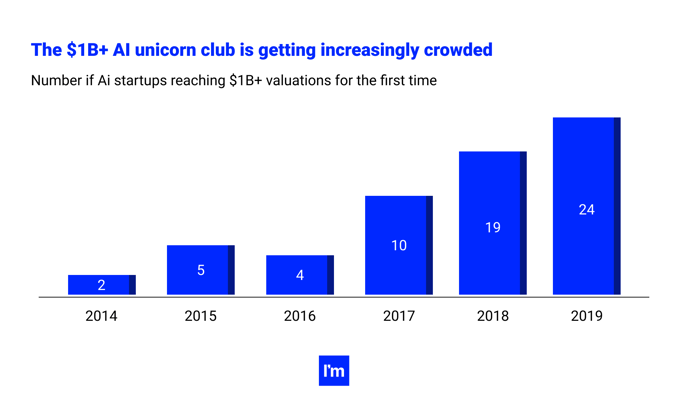
44. Among the areas of investment, healthcare was in the lead - in the corresponding AI companies, investors invested $ 4 billion at the end of 2019. It is followed by industries such as finance ($ 2.2 billion), retail ($ 1.5 billion), sales, and cybersecurity. M&A activity was also the highest in healthcare, sales, and retail. (Source: CB Insights: AI startup funding hit a new high of $26.6 billion in 2019)
45. In addition, in 2019, the number of AI companies whose value exceeded $ 1 billion grew. Among the new "unicorns" are the developer of autonomous robots for delivering goods Nuro and analytical company DataRobot. All ten new billionaire companies are based in China, the UK, or the USA. Such venture capitalists, Plug and Play Ventures, Accel and Lightspeed Ventures, were among the top AI investing leaders in 2019. (Source: CB Insights)
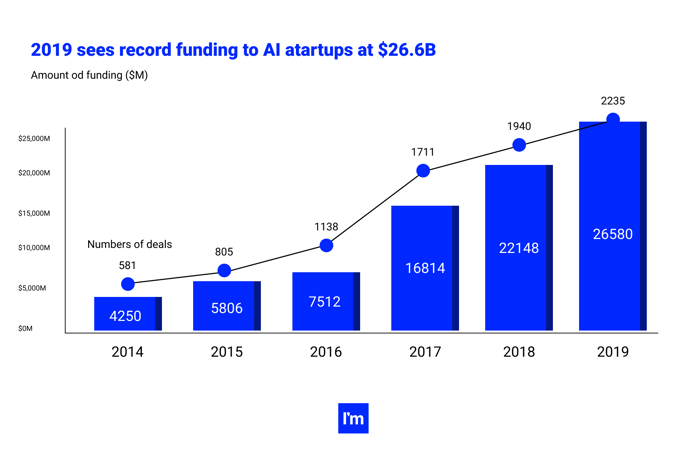
46. At the end of December 2019, Stanford University released the results of a study according to which the computing power of artificial intelligence has been ahead of Moore's Law for more than seven years. This law states that the processor speed doubles every 18 months, which means that developers can expect a doubling of application performance within that time frame for the same hardware cost. (Source: Stanford University finds that AI is outpacing Moore’s Law)
47. Researchers studied how AI algorithms have improved over time by tracking the progress of ImageNet's image identification program. Given that image classification techniques are heavily based on supervised machine learning techniques, the report's authors looked at how long it takes to train an AI model and the associated costs. (Source: Stanford University finds that AI is outpacing Moore’s Law)
48. The study found that in 18 months, the time it takes to train a network on a cloud infrastructure dropped from three hours in October 2017 to 88 seconds in July 2019. The authors of the report used the ResNet model to estimate how long it takes image classification algorithms to achieve a high level of accuracy. (Source: Stanford University finds that AI is outpacing Moore’s Law)
49. In October 2017, it took 13 days of training to achieve accuracy above 93%, costing developers $ 2323. The latest benchmark, available on Stanford's DAWNBench platform in September 2018, with an image classification accuracy of just over 93%, cost just over $ 12. (Source: Stanford University finds that AI is outpacing Moore’s Law)
50. Today, only 23% of businesses have implemented AI in their processes and product / service offerings. (Source: Forbes)
51. The largest companies (with at least 100,000 employees) are likely to have an AI strategy, but only half really have it (Source: Reshaping Business With Artificial Intelligence).
52. 63% of businesses say pressure to cut costs will require them to use AI (Source: Forbes).
53. 54% of CEOs say AI solutions implemented in their enterprises have already improved productivity (Source: What to expect from artificial intelligence (AI) in 2018).
54. 61% of business leaders using an innovation strategy say they use AI to uncover opportunities in data that would otherwise be missed (Source: 62% of Organizations Will Be Using Artificial Intelligence (AI) Technologies by 2018).
55. In Q2 2019, artificial intelligence startups received $ 7.4 billion in funding, the highest on record. The number of deals also grew. There were 488 deals on artificial intelligence. (Source: AI Startup Funding Reaches Record High)
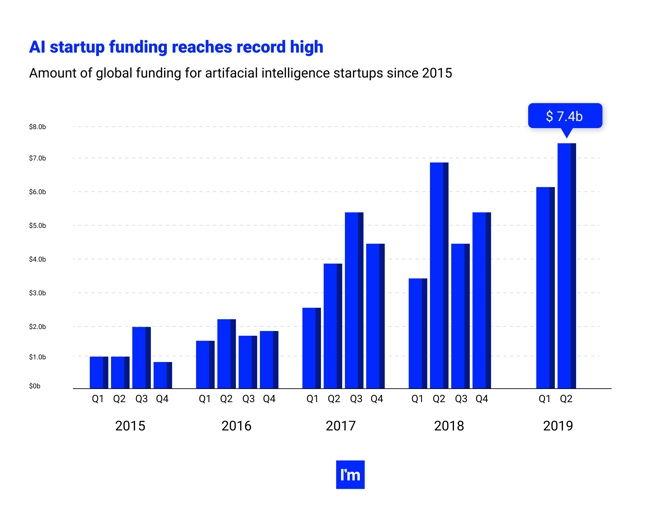
56. 40% of European startups doing AI development do not actually use it. This conclusion was made by analysts of the venture capital company MMC Ventures based on a survey of 2,800 startups in 13 EU countries published in March 2019. (Source: Forty percent of ‘AI startups’ in Europe don’t actually use AI, claims report)
57. MMC studied the most popular regions and directions among startups that are really engaged in AI. Most of these startups are in Britain - 479 by March 2019, followed by France (217 startups), Germany (196), Spain (166), and the Netherlands (103). (Source: Forty percent of ‘AI startups’ in Europe don’t actually use AI, claims report)
58. As for the spheres, most of the startups are engaged in developments related to medicine and health maintenance. (Source: Forty percent of ‘AI startups’ in Europe don’t actually use AI, claims report)
59. According to analysts of the international consulting company Frost & Sullivan, by 2022, the total volume of the market for AI technologies will increase to $ 52.5 billion, or 4 times compared to the level of 2017 ($ 13.4 billion). Annual Growth Rate (CAGR) will remain at 31% during the forecast period. The widespread introduction of AI technologies by 2030 will increase the volume of the global market for goods and services by $ 15.7 trillion, Frost & Sullivan reported on January 15, 2019. (Source: Artificial intelligence as part of a company’s intellectual potential)
60. As per Frost & Sullivan artificial intelligence statistics, the US remains the leader in terms of investment in AI technologies, and the number of deals concluded, followed by China and the UK. However, if we take into account the average cost of a deal, then the undisputed leader is China, whose average deal size in the last 2 years was more than $ 100 million against $ 15 million and $ 5.4 million for the United States and Great Britain, respectively. (Source: Artificial intelligence as part of a company’s intellectual potential)
61. China is actively developing in the direction of AI technologies. In 2017, the share of global investment that came to Chinese startups for the first time exceeded the share of American companies and amounted to 48%. (Source: Artificial intelligence as part of a company’s intellectual potential)
62. At the same time, 54% of all AI startups are located in the United States and only 15% in China. This rise in the popularity of artificial intelligence in China is due to the fact that the local government is actively promoting the technology in many industries, from agriculture to the defense industry. If this market for AI technology continues to grow at this rate, the United States risks losing its leading position, and China has every chance of becoming a world leader in the development and application of technology. (Source: Artificial intelligence as part of a company’s intellectual potential)
63. The most popular companies among investors in 2018 were Chinese SenseTime ($ 1200 million in investments), UBTech Robotics ($ 820 million), Megvii Technology ($ 600 million), YITU Technology ($ 300 million), and American Dataminer ($ 391 million), CrowdStrike ($ 200 million) and Pony.ai ($ 214 million), Frost & Sullivan noted. AI tech startups have caught the attention of companies like Alibaba Group, Fidelity International, General Atlantic, Accel, and others. (Source: Artificial intelligence as part of a company’s intellectual potential)
64. In healthcare, AI is mainly used to identify patterns in medical data and can significantly improve the accuracy of treatment, minimizing the possibility of false diagnoses and, as a result, reducing treatment costs. Thus, the California-based startup HealthTap has developed an application that analyzes the records of more than 100 thousand doctors to identify the most accurate diagnosis. (Source: Artificial intelligence as part of a company’s intellectual potential)
65. AI is also transforming the cybersecurity landscape, enabling innovations to defend against threats that traditional network security cannot detect. The specialists of the Deep Instinct company (Israel) have developed their own deep learning algorithms (one of the areas of AI), which can detect anomalies in network behavior and the presence of targeted cyberattacks (APTs) that cannot be detected using traditional technologies. (Source: Artificial intelligence as part of a company’s intellectual potential)
66. The impact of AI applications is also extending to industries such as ICT, banking and finance, automotive, video games, and entertainment. According to Stepanov, in the future, the influence of AI applications will increase, including in the aerospace and defense industries, energy, and retail. (Source: Artificial intelligence as part of a company’s intellectual potential)
67. According to Frost & Sullivan analysts, the steady growth of the AI technology market in the world will also be driven by the integration of smart applications in areas such as robotics, the creation and development of cognitive, neuromorphic, quantum, and large-scale computing systems. (Source: Artificial intelligence as part of a company’s intellectual potential)
68. The agricultural AI market is expected to reach $ 4 billion by 2026. (Source: AI in Agriculture Market by Technology, Offering, Application | COVID-19 Impact Analysis)
69. AI helps farmers predict crop accuracy and quality. (Source: Forbes)

AI Trends
70. 72% of tech, media and telecommunications companies expect AI to have a significant impact on product offerings over the next five years (Source: Forbes).
71. Juniper predicts that in 2022, the share of successful interactions with bots in the healthcare sector (which are performed without handing over to a human operator) will exceed 75% (Source: Chatbots, a Game Changer for Banking & Healthcare, Saving $8 billion Annually by 2022).
72. In the banking sector, Juniper predicts more than 90% successful interactions with bots by 2022 (Source: Chatbots, a Game Changer for Banking & Healthcare, Saving $8 billion Annually by 2022).
73. Key applications of artificial intelligence in clinical medicine have the potential to bring the US economy $ 150 billion in annual savings by 2026 (Source: The state of AI: 10 eye-opening statistics).
Chatbots
74. 80% of sales and marketing executives say they already use chatbot software in their customer experience, or plan to do so by 2020 (Source: Can Virtual Experiences Replace Reality?).
75. The main advantages of chatbots are 24/7 service (64%), instant responses to inquiries (55%) and answers to simple questions (55%) (Source: by SurveyMonkey Audience).
76. Juniper predicts that chatbots will save more than $ 8 billion annually by 2022 (Source: Chatbot Conversations to deliver $8 billion in Cost savings by 2022).

Virtual Assistants
77. Gartner predicts that by 2020, data collected from users in cloud-based neural networks will drive 40% of mobile interactions between virtual personal assistants and humans (Source: 10 Stats About Artificial Intelligence That Will Blow You Away).
78. According to the Pew Research Center (source), 46% of US adults use digital voice assistants to interact with smartphones and other devices. (Source: Voice assistants used by 46% of Americans, mostly on smartphones)
79. 55% of US adults use digital voice assistants to interact hands-free with devices (Source: Voice assistants used by 46% of Americans, mostly on smartphones).
80. 72% of business leaders say they use digital assistants to make their life easier (Source: Consumer Intelligence Series: Artificial Intelligence).
81. Gartner predicts that by 2020, zero user interfaces will be available on two billion IoT devices and endpoints (Source: Gartner Says by 2019, 20 Percent of User Interactions With Smartphones Will Take Place via VPAs).
Sales
82. Gartner predicts that by 2020, 30% of all B2B companies will use AI to improve at least one of their core sales processes (Source: Gartner Says 25 Percent of Customer Service Operations Will Use Virtual Customer Assistants by 2020).
83. A Harvard Business Review study found that companies using AI for sales were able to increase leads by more than 50%, reduce call times by 60-70%, and achieve cost savings of 40-60% (Source: Why Salespeople Need to Develop “Machine Intelligence”).
84. Forrester predicts that by 2020, one million B2B sellers in the US will lose their jobs due to self-service e-commerce (Source: Newsroom Posts Archive · Forrester).
Marketing
85. 80% of B2B marketing executives predict that AI will revolutionize their industry by 2020 (Source: 80 Percent of all Marketing Executives Predict Artificial Intelligence Will Revolutionize Marketing by 2020 | Account-Based Marketing).
86. 64% of B2B marketers consider artificial intelligence to be valuable for their sales and marketing strategy (Source: Everstring).
87. 63% of B2B marketers do not use AI in their technology stack (Source: Everstring).
88. Only 13% of B2B marketers are very confident in their knowledge of AI, 55% are somewhat confident, and 33% are not at all confident (Source: Everstring).
89. 71% of B2B marketers are interested in using AI for personalization (Source: Everstring).
90. 63% of B2B marketers are interested in using AI to identify trends (Source: Everstring).
91. 59% of B2B marketers expect AI to help identify leads (Source: Everstring).
92. 53% of B2B marketers expect AI to improve marketing performance to drive revenue (Source: Everstring).
93. Marketers say the main obstacle to integrating AI is its application in their current role and workflow (33%) (Source: 2018 Future of Marketing and AI Survey).
94. Marketers say the main success story they see with AI is better customer understanding (31%) (Source: 2018 Future of Marketing and AI Survey).
Customer Service
95. Servion Global Solutions predicts that by 2025 AI will drive 95% of all customer interactions, including live phone calls and online conversations (Source: AI Will Power 95% Of Customer Interactions By 2025 – Finance Digest).
96. Gartner predicts that by 2020, customers will manage 85% of their business relationships without human interaction (Source: Gartner Customer 360 Summit 2011).
97. 78% of brands say they have already implemented or plan to implement artificial intelligence and virtual reality by 2020 to better serve their customers (Source: Can Virtual Experiences Replace Reality?).
98. Only 27% of global consumers say AI can provide the same or better services than humans. However, 38% say AI will improve customer service soon (Source: 73% of global consumers).
99. 73% of consumers worldwide say they are open to AI business if it makes life easier (Source: 73% of global consumers).
100. 43% of millennials would pay more for a hybrid human-bot customer service channel (Source: Consumer Intelligence Series: Artificial Intelligence).


Co-Founder of Ideamotive. Highly skilled in Ruby on Rails, JavaScript and Linux System Administration. Experienced in implementing effective web apps.
View all author posts
Trending articles
21 Dazzling Examples of Mobile App UI Design to Inspire You in 2023
Michał Pruciak 7 min read
MedTech vs HealthTech vs BioTech: What Are The Differences?
Michał Pruciak 7 min read
10 Business Applications of Neural Network (With Examples!)
Michał Pruciak 4 min read
10 Irresistible Examples of Web Design Best Practices for 2023
Adam Kozłowski 7 min read
21 Amazing Examples Of React Web Development
Michał Pruciak 14 min read
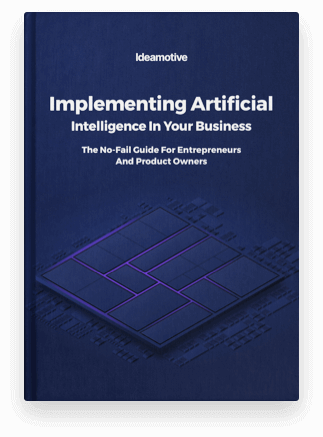
Implementing Artificial Intelligence In Your Business
The No-Fail Guide For Entrepreneurs And Product Owners
Read nowRead more featured publications and articles
Looking for a specific type of AI development service?
Looking for AI experts to join your team?
There are dozens of vetted AI professionals in our talent network.
Rated 4.8 / 5.0 by clients from various industries and locations.
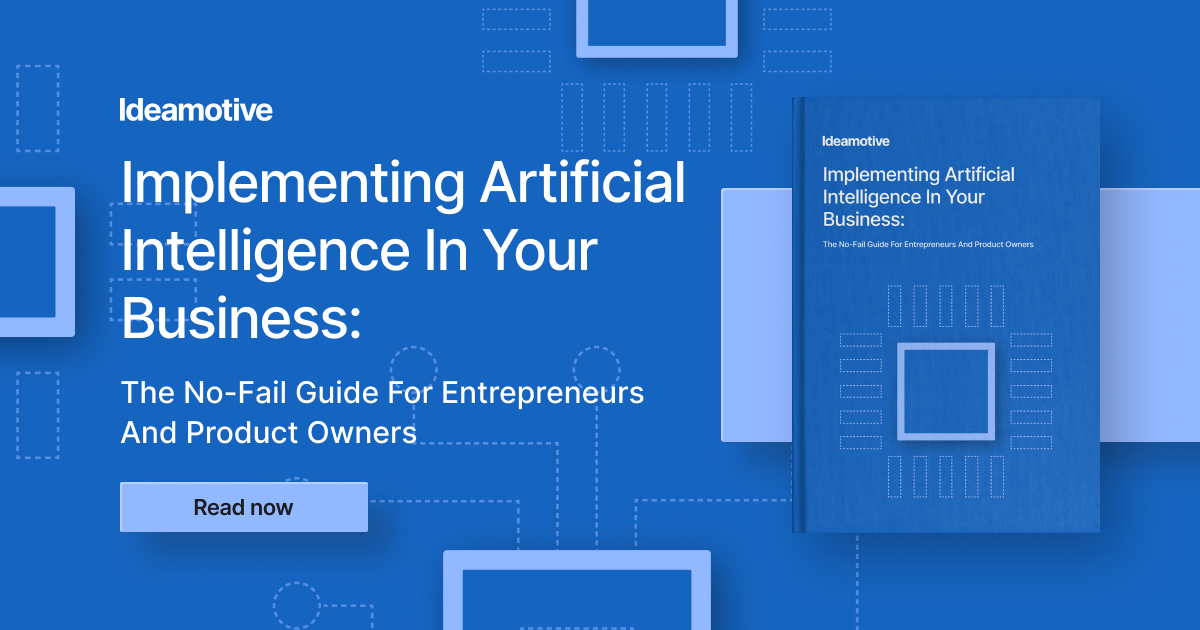
.png?width=1584&name=Python_%20The%20Definitive%20Business%20Guide%20-%20blog%20banner%201584x396%20(1).png)
-1.png)
